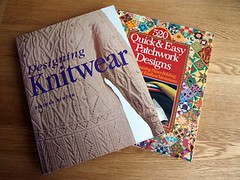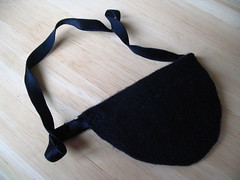It’s getting harder to find decent second-hand bookshops in central London these days so we recently took a trip to Hay-on-Wye to satisfy our cravings. I spent a fair amount of time rummaging through any craft books I could find and managed to pick up a few interesting additions to my library. I plan on writing fuller reviews once I’ve had the chance to read them more carefully and try some projects but here’s a quick look in the meantime.
Alabama Stitch Book, by Natalie Chanin with Stacie Stukin:
A collection of sewing projects for recycling and embellishing old t-shirts. I first heard of this book when the House on Hill Road blog reviewed the follow-up book Alabama Studio Style. Having now seen this book and the review of the second one at House on Hill Road, I think the projects in the second book are probably more to my taste but there are a couple of projects in here, including a skirt and corset top, that I do really want to try. All I need now are some t-shirts!
Designing Knitwear, Deborah Newton:
I’ve been getting more ambitious with my designing (I currently have a couple of lace shawls in progress) and my eventual ambition is to learn how to design clothing. I had seen this book recommended as a good guide to knitting design and, at a first glance, it certainly seems to cover everything you could want to know. In fact, at first glance, the sheer quantity of text and detail in this book is a little overwhelming. I think this is going to be a book that I sit down and read through rather than dipping in and out of. I’ll let you know how that goes later.
520 Quick and Easy Patchwork Designs, Kei Kobayashi:
The concept behind this book is simple: using folded origami squares as the basis for quilt designs. Take your square of paper, fold your shape, unfold the paper and use the geometric pattern of crease lines as the basis for your quilt block. My quilting has yet to progress beyond simple patchwork blocks but there’s a wealth of inspiration in here for anyone from the absolute beginner to the expert looking for something new. There is a large section on traditional American quilt block patterns, as well as variations on geometric patterns and some Art Deco and computer graphic suggestions as well. It is a design book rather than a how-to-quilt book so if you’re looking for detailed guidance on quilting, piecing and finishing quilts, this isn’t the book for you but if you’re looking for inspiration, there’s plenty of it here.










